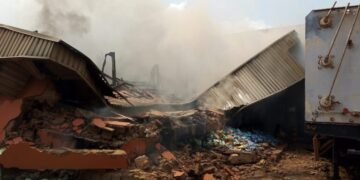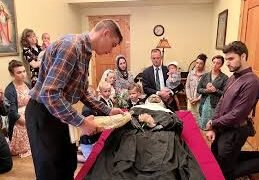Rev. Fr. Paschal Onwugbenu
Education is a basic right, and requirement for the right development of every child, everyone. While it is obvious that education takes place in different places and I would argue, in ALL places, the type of education (formal) that goes on in schools is the most prominent in our part of the world.
It is important to note that the State is usually the primary provider of human capital development institutions like hospitals and schools. She is not a supporter to other agencies in those areas. This much has been said by Prof. Chukwuma Soludo, the Executive Governor of Anambra State. Everyone who is objective would readily agree with the governor in his assertion. However, contexts makes all the difference in issues like the ones raised by the governor. In our area of the world, especially, our Anambra State, nay South Eastern States of Nigeria, the State has almost consistently played the supporter role to other agencies in the provision of these social infrastructures. Except for about 2-4 decades after the Nigeria Civil war, the government, NEVER, was the primary provider of Education and Healthcare in Anambra State, nay South East of Nigeria.
Using educational institutions as examples, before 1968, the State has the least number of schools she established, compared to those established by Voluntary Agencies, Towns and Private Individuals. Today, using the primary schools as case in point, the Anambra State government has a little over 300 primary schools (code named public public). These include both the schools established by individuals, towns, and the government itself. The Voluntary Agencies have over 700 (code named Mission Public, just counting pre-1968) schools. Going by the above, even when the schools built by the Towns and private individuals are counted for the government, it still has less than 50% of what the Voluntary Agencies had. The only conclusion from this, going by history, is that the Government, through grants-in-aid, was a grand supporter NOT provider of education to the teeming masses of the state. It does not reflect our history when some people argue that it was after the Civil war that the Missions and Private individuals stepped in as stop-gap when the government slacked in her duties.
What is true is that the grant-in-aid being provided by the government, made education appear cheaper and offered more access to poor children to climb up the social ladder. The key indicator in this process is the availability of grant-in-aid NOT the actual cost of the services provided!
If then, today, it appears that the cost of the services provided in Mission schools are high and this represents the actual cost of what is given, perhaps, the cushion that grant-in-aid was providing, which is no more, should be the greatest factor responsible for the rise in fees not that the pricing of services has gone up.
When one add up the newer schools built after 1971 till date, the number of government owned schools pales in significance (less than 20 %) to those owned and controlled by Voluntary Agencies (Missions) and Private Individuals. It goes again to say that the government is even farther from being the primary provider of education to the children of the state. It is left with the duty of playing the supporter to the providers.
This duty was being carried out faithfully and effectively before the Nigerian Civil war. The support of the government to education-provider agencies afforded the government the opportunity to supervise and monitor the quality of services thus provided. When the government assumed the duty of both the provider and supervisor, the common experience has been one being a judge in his own case and has one possible objective outcome: the public loses!
In the most recent years, due to the collapse of the Public System of education where schools are financed largely by the government to create equal access for every child in the society something has changed. Our experience since after the Civil War in Anambra State is that government has not come up to speed in the provision of such necessary amenities for the ever increasing citizenry especially in the urban areas and satellite towns fueled by the Rural-urban migration.
The gap created by the absence of government provision of these necessary amenities is being filled by the Missions and Private individuals. It is noteworthy that most new satellite towns in, and around Onitsha and Awka have grossly insufficient number of public primary and secondary schools if ever, they have one at all. We are not in any way indicting the present government, though we desire strongly, to see the State providing those facilities for the teeming masses of our dear state.
Given that the government is struggling to, significantly, fund public schools, the prevalent opinion in the society is that there is dearth of quality in public schools and many parents would only send their children to public schools if their efforts at getting into Mission or Private schools have failed. Public school system is not seen as an option but an unwanted fallback just to be in school when all other options have failed. The government has at different times, made attempt to support quite a few of the non-public schools. While those efforts are commendable, they were, merely, drops in the ocean considering the enormity of the challenges faced daily in the provision of quality education. As parents cough out money from their meagre savings to pay school fees in those non public schools, they are so squeezed that many began thinking aloud that Mission Schools are expensive. But are they?
This is the focus of our discussions here.
It is my considerable view that the idea and concept that Mission Schools are expensive is misconstrued.
Fees
Schools are priced based on the programs being offered and the quality of those programs. School A may offer only general Mathematics and School B offer both General Mathematics and Further Mathematics. Many times, it is not all teachers that teach Further Mathematics hence there may have to be separate teachers for General Mathematics and Further Mathematics. Again, when you employ a novice teacher or an effective teacher. Note that I was deliberate in not saying an experienced teacher because many times, length of years in a particular work does not always mean depth of effectiveness.
Besides, a school may have very functional laboratories where experiments are carried out by the students. These students use chemicals (reagents) and sometimes break the equipment (burettes and pipettes etc) in the course of their learning. These have to be bought again and again especially as Senior School Certificate examination draw closer. In subjects where the students struggle despite the good efforts of the teachers, good school administrators invite an expert to not only coach the teachers but sometimes to teach the students directly.
Moreso, the quality of the classroom and extra-curricular activities like Music Orchestra, Good Sports facilities, Coaches for debating and acting skills etc are not equally present in all the schools. However, they are NECESSARY for overall development of our children.
The right cost of school fees, therefore, is the total sum of all programs offered in the school below which it would be a disservice to our children for their future. What people should look out for, is whether the programs offered are above the minimum requirement for the good of the children. When a school lack teachers and do not use laboratories etc and charge people less, they compare that with others who have full programs. The tragedy is that they would prefer all the programs in the better school at the cost of the less good school. How can that happen? Who will pay for the differential cost? How unfair it can be to want a car and decide to pay the price of a motorcycle then turn around and shout that the automobile is expensive?
Comparative cost analysis
Following the point made above, it is important to actually see if the Mission Schools are overpriced or that some people want to get a premium value at ordinary cost. Comparative analysis helps a lot in determining if there is price mark up by a similar institution or firm. When we note the programs being run in specific Mission schools and match them against private schools who offer similar programs, we can see how it scores with the price tag of those programs in Mission schools. In this way, we can see what is the administrative cost of the program and possible profits from it then observe if the Churches are actually feeding fat on the people whose wards are in their school.
Infrastructure
Psychology has a lot to do with learning. There is a reason why formal attire is required of teachers and other members of staff while in school: formal education is official business. Therefore, the place where this business is being done would have to be in such a condition as to manifest that seriousness. Dirty walls, broken windows, pothole-filled floors, leaky roof, and damaged board all speak to the seriousness of the event done inside the building. Officially termed enabling environment, every good school administrator should take care of renovations, reconstructions and rehabilitation of the school building plant to signify, to the students, and indeed all who come into the school environment of what takes place there. Can anyone expect students to give their best in a poultry like environment?
Getting the buildings right is not about appearance, but for their huge impact on the psyche of the students. No one can train a gentleman in pig’s house says Archbishop Valerian Okeke. It goes to show that the level of preparation of an environment does a lot in showing the real intention of the management. Dilapidated buildings, patched up walls, leaky roofs, broken pieces of woods and half-torn window panes do not show the serious ness of the business of education. Children and young adults would come in and never tune in to what they are expected to. Somehow, everyone knows how environment impacts of the level of attention and engagement students are ready to manifest.
Moreso, structure enables process. This means that the buildings determine how the process of teaching and learning can be. An instance is that a square or rectangular classrooms where there are heavy lockers filled with books can only enable lecture method excluding other methods like small groups and half-lunar shape among others. To keep rehabilitating school buildings in order to get them to the level of enabling solid and quality learning takes years.
One of my greatest worries and indeed grave concern is that none of our schools have regained the image they had as at 1967 not to mention what they should be in 2023. Somehow, people cannot see how far behind we are and attack those who try to inch it closer to its past level in order to find our way to the present. Without the right infrastructure, the process of learning will continue to be impeded. The sad fact about all these is that while we drag our feet in getting it right, our children cannot wait. They will be graduating every year with such shallow level of learning. To allow that to continue is to perpetuate the culture of mediocrity while hoping for genius outputs. This means that any savings from school ploughed back into rehabilitating the school building plant goes back to support more quality education delivery and therefore, not an increase in profit for the management. Asking the management to stop this action is put a ceiling on the growth of our children which no right thinking person will ever endorse.
The demands of parents
Parents of students in schools have diverse needs. Those needs play into certain decisions of the management to satisfy the parents/guardians. Over time, parents have found that finding time to traverse the market picking school items for their children can be stressful. Many of them begged and even nudged the schools to get the items from the suppliers in bulk, and bring to the school for the parents to merely pay certain amount and pick, on arrival. The ease, time saving, and stress free process, in addition to getting most items cheaper than when bought singly from the market, made the schools to accept the proposal. Now, how these items became school fees beats everyone’s imagination.
We need to understand that for such arrangement to be reasonable, the quantity is essential for price drop. More so, the minority are always meant to accept the decisions of the majority. Sometimes, in a school of 1,000 students, 60 parents may object and 6 of them collaborate with each other on the media attacking that particular decision. The world hears the opinion of the 6 aggrieved parents and conclude that their opinion is held by all the parents. These are used against the school albeit very erroneously. The demands for convenience of the parents acquiesced to, by the school cannot be imputed to the school as tuition.
v. Market forces
In running any establishment, there are always factors that the administrator control and those beyond his control. The cost of materials and foodstuffs are always beyond the control of the administrator. Therefore, market forces and immediate realities have huge impact on the fees payable in any school. The present cost or a bag of rice and tubers of yams among others offer more insight to our reality. There is always some form of denial among people. Many would decry the high cost of foodstuffs and sundry materials but somehow think that schools or other people have a different market from where they purchase their living items. Indeed, in our local markets, the economy of bulk purchase of foodstuffs does not offer significant discount. No thanks to the security situations in the remote villages where the primary suppliers are met, most foodstuffs are sourced through secondary marketers if at all. The purchase of 1 tuber of yam and 200 tubers from the local market, in the hands of secondary dealers, does not really yield significant differential anymore. We can, then, understand how schools manage their resources with some foodstuffs they cannot stockpile for a very long time like yams. They must have to purchase monthly or thereabout to avoid damages.
Conclusion
Things are expensive based on the cost of production or profit margin. It is easier to get a cut in price when the profit margin in high, otherwise, cutting into the production cost will be a gradual journey into extinction. Getting a cut in the cost of production takes time and is dependent on discovering cheaper source of the same quality materials, or finding more efficient materials that use fewer quantity to give similar outcomes than the previous materials being used.
In running schools, given the factors discussed above, in the recognition that they are not exhaustive, it is not difficult to argue that Mission schools are not expensive, meaning that their balance, after expenditure margin, is lean. The bite that parents feel is as a result of other factors most of which are outside the control of the Missions. It is important that we appreciate the efforts of the mission that insist of some minimum quality education which our children must have for them to be well prepared to face the challenges of their life in the future. It means that the Mission agents have focus for a better society.
Given that the “the cost of production” of school goods and services account for the level of fees being paid, asking the schools to reduce the fees would be to ask them to cut some services they offer to our children. Can we agree on which service that is not necessary for the development of critical and creative thinking, leading to problem-solving skills that our children need? In fact, do we want under-prepared children to face the global competition or those who can compete with their peers wherever they are from?
It seems to me that the right questions to ask would be that schools show us how the programs are working for our children and demand that certain important programs like computer coding be made compulsory in our secondary schools, at least. In that way, we will be assured of children prepared to face the world irrespective of what it throws at them, than certificate holders who cannot help themselves with the piece of paper they have in hand, ultimately, becoming liabilities to us.
In the alternative, we can all ask the State to consider voucher program for every student in Anambra State which can give access to any school within the State. That will subsidize quality education, grant access to the poor and raise the human capital index in our dear state.















































